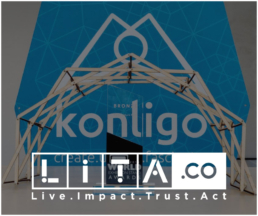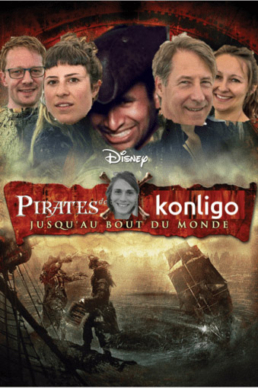300.000€ to revolutionize the event industry thanks to Konligo !
**Nederlands onderaan**
300.000€ POUR RÉVOLUTIONNER L'ÉVÉNEMENTIEL GRÂCE A KONLIGO
Les stands durables, modulables, compacts et extrêmement faciles à installer de Konligo ont fait fureur auprès des investisseurs sur LITA.co qui ont soutenu en masse cette spin-off de la VUB en quelques jours de levée de fonds.
Contexte
En quelques jours à peine, Konligo, spin-off de la Vrije Universiteit Brussel (VUB), a rassemblé de nombreux actionnaires via LITA.co. Ils ont investi pour permettre l’accélération du développement de la start-up qui crée des structures en aluminium recyclé hyper compactes, faciles à installer, modulables et durables pour le secteur de l’événementiel.
Impact écologique
Les stands et structures pop-up de Konligo peuvent être réutilisés entre 50 et 200 fois. Traditionnellement, les structures temporaires utilisées dans l’événementiel consomment une grande quantité d’énergie et de ressources lors de leur production. Elles sont ensuite jetées après une ou deux utilisations seulement. La technologie de rupture proposée par Konligo permet de réduire non seulement la quantité de déchets par événement, mais aussi les émissions de gaz à effet de serre résultant de leur production. De plus, ces structures inédites sur le marché offrent un gain de temps d’installation incroyable, et diminuent l’espace de stockage nécessaire.

Impact social
Konligo, c’est aussi et surtout des valeurs. Des valeurs écologiques comme mentionné ci-dessus, mais également des valeurs humaines, que l’entreprise affiche fièrement dans ses locaux. La joie, la communication, l’empathie, la responsabilisation et le développement personnel sont autant de valeurs que Konligo s’efforce de mettre en œuvre au sein de son équipe, de partager et de respecter, que ce soit lors du choix des partenaires ou dans la relation avec ses clients. Car Konligo vise avant tout à rassembler. Le mot ‘’konligo’’, dérivé de l’esperanto, signifie d’ailleurs ‘’lier’’. Ainsi, leurs structures doivent-elles permettre de rassembler les gens autour du sport, de l’art, du commerce, de la science ou de l’humanisme dans un environnement magique. Magique ? Oui ! Il suffit de regarder les vidéos disponibles sur le site internet de Konligo pour vous émerveiller devant la transformation des branches en aluminium en stand, salle d’exposition ou podium spectaculaires.
Futur
L'objectif initial de Konligo était de vendre ces structures à des ONGs humanitaires au coût de production. Avec des tentes installées rapidement et facilement transportables, Konligo est persuadé de la plus-value de son produit dans des situations d’urgence. Cet objectif n’a pas été oublié. Lors d’une interview avec LITA.co, Aushim Koumar, fondateur de Konligo, explique qu’« à partir de 2020, nous allons mettre 2.5% de notre CA dans un fonds pour financer l'adaptation de notre produit pour des hôpitaux d’urgences et des acteurs humanitaires ».
Ce crowdfunding record est une belle étape dans leur stratégie de développement en cours et le potentiel de leurs produits semble leur ouvrir de grandes perspectives. Histoire prometteuse, à suivre dans les mois à venir !
******
300.000€ OM DE EVENTSECTOR TE REVOLUTIONEREN DANKZIJ KONLIGO
Konligo's duurzame, modulaire, compacte en eenvoudig te installeren stands waren een hit bij investeerders bij LITA.co, die deze VUB spin-off massief hebben ondersteund tijdens de enkele dagen van haar fundraising.
Context
Konligo, een spin-off van de Vrije Universiteit Brussel (VUB), bracht in slechts een paar dagen tijd talrijke aandeelhouders samen via LITA.co. Ze investeerden om de ontwikkeling van de startup, die hypercompacte, gemakkelijk te installeren, modulaire en duurzame gerecycleerde aluminium structuren produceert voor de eventsector, te versnellen.
Ecologische impact
Konligo stands en pop-up structuren kunnen tussen de 50 en 200 keer worden hergebruikt. Traditioneel verbruiken tijdelijke structuren die bij evenementen worden gebruikt een grote hoeveelheid energie en grondstoffen tijdens de productiefase. Ze worden dan na slechts één of twee gebruik weggegooid. De baanbrekende technologie van Konligo vermindert niet alleen de hoeveelheid afval per event, maar ook de uitstoot van broeikasgassen vanuit hun productie. Bovendien sparen deze nieuwe structuren enorm veel tijd tijdens de installatie, wat voor een kleinere opslagruimte zorgt.

Maatschappelijke impact
Bij Konligo gaat het ook, en vooral, over waarden. Ten eerste, ecologische waarden, zoals hier boven vermeld, maar ook humane waarden, die het bedrijf trots laat zien in haar kantoor. Vreugde, communicatie, empathie, empowerment en persoonlijke ontwikkeling zijn waarden waarvoor Konligo streeft binnen haar team, en dat ze deelt en respecteert, of het nu gaat om de keuze van partners of om de relatie met haar klanten. Want Konligo wil vooral mensen bij elkaar brengen. Het woord "konligo", afgeleid van Esperanto, betekent trouwens "verbinden". Hun structuren moeten dus mensen in staat stellen om samen te komen rond sport, kunst, business, wetenschap of humanisme in een magische omgeving. Magisch? Ja, bekijk de video's die beschikbaar zijn op de Konligo website en bewonder de transformatie van de aluminium takken tot een spectaculaire stand, showroom of podium!
Toekomst
Het oorspronkelijke doel van Konligo was om deze structuren aan humanitaire NGO's te verkopen aan de productiekost. Met snel en eenvoudig te transporteren tenten is Konligo ervan overtuigd dat haar product toegevoegde waarde brengt in noodsituaties. Deze doelstelling werd niet vergeten. In een interview met LITA.co legt Aushim Koumar, de oprichter van Konligo, uit: “vanaf 2020 zullen we 2,5% van onze omzet investeren in de aanpassing van onze producten voor noodziekenhuizen en humanitaire organisaties”.
Deze record-crowdfunding is een grote stap in Konligo’s huidige ontwikkelingsstrategie en het potentieel van haar producten lijkt grote perspectieven te openen. Veelbelovend verhaal, te volgen in de komende maanden!
What is it like to work at Konligo ?
What is it like to work at Konligo? Record from Capucine, Communication and Sustainability Intern
When I first arrived at Konligo, I didn’t know what to expect. For my future career, I have always wanted to work in an NGO, and this was my first internship. I didn’t know anything about the start-up world and was very curious to discover it.
I rapidly found out that since a start-up is basically a project coming to birth, it also means an exciting new adventure. And a new adventure means enthusiastic people, creative minds and most of all, loooads of ideas. In a start-up, there is always room for initiatives and new thoughts are more than welcome. You can just be your true self and give the craziest ideas you can have (not guaranteed they’ll be accepted but hey, if you don’t try, you’ll never know, right?) And if you fail, you can always retry and learn from your mistakes in order to succeed better later. Taking risks is part of the game!
Be yourself, accept the challenges and confront yourself to get out of your comfort zone. Working in a start-up like Konligo is also about working with people full of energy and dynamism, it is taking risks but not being afraid of it. Just like skydiving! If you don’t want to jump out of the plane, you’ll never experience this very unique excitement and this amazing feeling of watching our dear Earth from above (and the terrible feeling of having your cheeks detached from your face, looking like Shrek’s donkey). Even though a start-up means that you don’t know how the next day will look like, it is good to keep moving, to bring changes and new opportunities. It is based on uncertainty regarding the projects, the team members, the financial situation or how you will be able to address the clients’ needs... You really have to involve a lot of your time and energy in the project but hard work always leads to results, either positive or negative, but at least you can learn from them.
A start-up like Konligo is the place where you bring everyone’s skills together, to create relationships and great team working moments. It is about gathering around a common project, doing several (and sometimes super different) tasks, with different (but always creative) people! In Konligo, it is about communicating, pitching your project, getting feedback, working on, logistics, sales but also writing articles or sourcing prospects, in French, in English, in Dutch… Start-ups don’t know boundaries! Working at Konligo made me discover new sectors, new functions and new people from different cultures, backgrounds and working areas.
For me, a start-up is like a baby to raise and to take care of. The “pregnancy time” is super exciting because it is all about planning how will it go, taking care of everything and being ready for the moment to give birth. And then when raising the “kid”, every development step is extremely important! Since everything there are so many things to do, being involved in such a process is a perfect occasion to teach, but also to learn a lot, from everyone, everything and every kind of situation. It is also the opportunity for “the family members” involved to discover new skills, to confront themselves during hard situations, having ups and downs but this is also part of life! Even struggling times can be appreciated because it is a challenge to overcome and once it’s done, it makes the efforts even more valuable.
So working for like Konligo is to me a unique experience that brings lots of responsibilities, risks to take, opportunities and opens some doors to new people, new discoveries and new adventures!
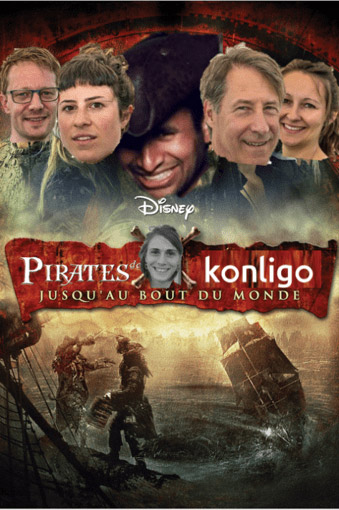
After only one year, Konligo receives an award at the World Exhibition Stand Awards 2019 !
**Version en français plus bas**
De Belgische Start-up Konligo wint de World Exhibition Stand Awards na slechts één jaar op de markt te zijn !
Konligo, de Brusselse spin-off van de VUB die innovatieve, inspirerende en duurzame stand structuren ontwikkelt voor alle type evenementen en beurzen heeft een prijs gewonnen: de World Exhibition Stand Awards 2019.
In de categorie “Best Feature Area’ behaalt Konligo de bronze medaille voor zijn ontworpen stand voor de beurs MoOD + Indigo, georganiseerd door Easyfairs. De structuur op de expositie werd opgebouwd uit twee modules van de Ondo (naam van het product) en versierd door het creatieve, Gentse agentschap Big Fish.
De expertise van Konligo is het ontwikkelen van duurzame structuren in 80% gerecycleerd aluminium die men snel en gemakkelijk kan opstellen en weer opplooien.
Het voordeel is dat de structuren erg elegant en herbruikbaar zijn en daarbovenop kunnen worden gepersonaliseerd.
De missie die Konligo nastreeft is bewijzen dat het mogelijk is om korte evenementen te organiseren die duurzamer zijn.
“Het is heel verheugend en bemoedigend om een prijs te ontvangen voor ons werk, het bewijst dat er inderdaad een bewustzijn is voor multifunctionaliteit zonder de creativiteit en de esthetiek te verwaarlozen.” Vertelt Aushim Koumar, de oprichter van de start-up. “We kijken er naar uit om onze structuur opnieuw bloot te stellen aan een andere context, zodat we het een ander uiterlijk kunnen geven en het ontwerp potentieel verder kunnen verkennen. “
Konligo blijft nieuwe, inspirerende modellen en vormen ontwikkelen die alle exposanten en bezoekers de mogelijkheid geeft om unieke en ongekende ervaringen te beleven.
Voor meer informatie, www.konligo.com / en abonneer op @Konligo op Twitter en Instagram
*******
La Start-up Belge Konligo remporte le World Exhibition Stand Awards après tout juste un an sur le marché!
Konligo, la spin-off Bruxelloise de la VUB qui développe des structures de stand innovantes, inspirantes et durables pour tous types d’évènements et salons reçoit un prix lors du concours du World Exhibition Stand Awards 2019.
Dans la catégorie “Meilleur Stand d’espace communs” Konligo remporte la médaille de bronze pour son stand développé lors du salon MoOD + Indigo organisé par Easyfairs. La structure installée pour ce salon était composée de deux modules de Ondo (nom du produit) et décorée par l’agence créative Gentoise Big Fish.
L’expertise de Konligo est de développer des structures durables en aluminium recyclé (à 80%) qui peuvent être déployées et repliées très facilement et rapidement. L’avantage qu’elles présentent est également d’être compactes, réutilisables et personnalisables à l’infini.
La mission que s’est donnée Konligo est de prouver qu’il est possible de faire des évènements éphémères plus durables.
“C’est vraiment gratifiant et encourageant de recevoir un prix pour notre travail, cela prouve qu’il y a effectivement une prise de conscience favorable au multi-usage, sans pour autant négliger la créativité et l’esthétique.” s’exprime Aushim Koumar, le fondateur de la start-up. “Nous avons hâte d’exposer de nouveau notre structure dans un autre contexte afin de pouvoir lui donner encore un look différent et d’explorer toujours plus son potentiel en matière de design.” ”
Konligo continue de développer de nouveaux modèles et formes inspirantes qui offrent à tous les exposants et visiteurs la possibilité de vivre des expériences uniques et inédites.
Pour plus d’information, www.konligo.com / Et abonnez-vous à @Konligo sur Twitter ou suivez-nous sur Instagram
The Start-up willing to make the event industry more sustainable celebrates its first anniversary !
**Version en français plus bas**
De start-up die de evenementenwereld wil veranderen, wordt 1 jaar!
Konligo, een Belgische startup die innovatieve, inspirerende en duurzame stand structuren ontwikkelt voor alle soorten evenementen blaast zijn eerste kaarsje uit.
Even een terugblik naar het eerste jaar.
Konligo is de vrucht van een perfecte samenwerking tussen Aushim Koumar, een ex-doctoraatstudent aan de VUB en zijn twee proffen: Niels de Temmerman (wereldwijd gekend voor zijn kennis over schaarstructuren) en Tine Tysmans ( expert in structurele optimalisatie en modellering). Na 15 jaar onderzoek, is het doel van Konligo om de ontwikkelde theoretische modellen en de opgedane kennis om te zetten naar een eindproduct dat een elegante en duurzame oplossing biedt voor de problemen binnen de evenementensector.
Het eerste jaar op de markt is dan ook gekenmerkt door grote successen zoals de aanwezigheid op een internationale beurs in Londen die veelbelovende vooruitzichten heeft geopend. De structuren die ontwikkeld zijn door Konligo hebben al meerdere grote spelers verleidt zoals Easyfair & Alter Expo en hebben aangetoond dat het duurzame en verantwoorde argument niet per se een noodzakelijk synoniem is aan een hogere prijs of een verwaarloosde stijl.
“We hopen dat ons product en ons duurzaam initiatief de ogen opent van de spelers in de evenementenindustrie. Er zijn al een hele hoop initiatieven genomen, maar de sector investeert nog te vaak in het gebruik van eenmalige structuren omdat ze denken dat dit de enige manier is om het gewenste wow-effect te creëren. Ze zien nog niet het potentieel en de eindeloze mogelijkheden die gepaard gaan met duurzaamheid en herbruikbaarheid. “
Konligo is zijn eerste jaar door en blijft investeren in het onderzoek en de ontwikkeling naar nieuwe structuren die nog meer compact, modulair en fascinerend zijn. Deze producten zijn ontworpen om te voldoen aan de eisen van de markt, de bezoekers en die van onze toekomstige generaties.
Voor meer informatie, www.konligo.com / en abonneer op @Konligo op Twitter en Instagram
*******
La start-up qui veut révolutionner durablement le monde des salons et foires fête ses 1 an !
Konligo, la start-up Belge qui développe des structures de stand innovantes, inspirantes et durables pour tous types d’évènements et salons souffle sa première bougie. Retour sur cette première année.
Konligo est le fruit d’une parfaite collaboration entre Aushim Koumar, un doctorant à la VUB et ses deux professeurs: Niels de Temmerman (mondialement reconnu pour son expertise en structures ciseaux) et Tine Tysmans (experte en optimisation structurelle et modélisation). Après 15 ans de recherches, l'objectif de Konligo a été de passer de modèles théoriques, basés sur de l'ingénierie créative à un produit fini qui offre une solution élégante et durable aux problèmes rencontrés par secteur de l'événementiel.
Cette première année sur le marché a été marquée par de belles réussites telles que la présentation à un salon international de renom à Londres et a ouverts des perspectives très prometteuses.
Les structures développées par Konligo ont déjà séduit plusieurs acteurs majeurs comme Easyfair & Alter Expo et réussissent à démontrer que l’argument durable et responsable n’est pas nécessairement synonyme de prix plus élevé ou de style négligé.
“On espère que notre produit et notre démarche vont ouvrir les yeux aux acteurs de l’industrie des évènements. Beaucoup d’initiatives ont déjà été prises, mais ce secteur investit encore trop souvent dans de l’usage unique en pensant que c’est le seul moyen de créer l’effet waouh recherché. Ils n’arrivent pas encore à voir suffisamment les opportunités et possibilités qu’offrent le durable et le réutilisable” précise Aushim Koumar, le fondateur de la Start-up.
Konligo passe ce cap des 1 an et continue d’investir en recherche et développement afin de proposer de nouvelles structures, encore plus compactes, modulables et fascinantes. Ces produits sont conçus pour répondre aux exigences du marché, des visiteurs mais aussi à celles de nos futures générations.
Pour plus d’information, www.konligo.com / Et abonnez-vous à @Konligo sur Twitter
How to make events more sustainable?
Every year, trade and consumer shows generate 600.000 tons of waste. That represents 1 billion pounds and makes this sector the second-worst waste producer after construction.
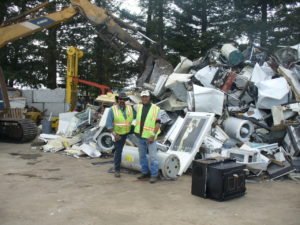
Most of this waste comes from all the flyers, posters, plastic bags, catalogs or cheap samples that are offered to visitors. In addition, there is the plastic that protects the carpets during assembly and the carpet itself during dismantling, which in most cases will never be reused. The stand carpet is usually packed in bulk, and the carpet located in the communal spaces is recycled. As the size of the trade show increases -and the proportion of stands with customized design (or non-reusable stands) with it the quantity of hazardous and wood waste can raise tremendously.
Of course, there are some simple solutions to this problem. Since nowadays we are living in a very technological/digital world, some tools could be really helpful in solving waste reduction in trade shows and fairs. Most people have a smartphone and a good way to avoid any waste (especially paper) is to develop an application or to use a QR code to collect the clients’ data for example, instead of losing time, energy and paper if done by hand. A digital catalog is a good alternative too, and is even more useful since the client can get access to any information and go through all the products on a tablet. The exhibitors can also provide reusable bags and biodegradable or even reusable beverage and food containers (plates and cups made out of cardboard or bamboo for example).
Why going paperless?
Going paperless is a good way to reduce waste and expenses: you avoid sending paper invites and printed advertisement memos by creating online event pages, apps and registering people via email, social networks and websites. Moreover, it gives quicker access to all of the internet information since it’s accessible at any time. An example is e-tickets as a very good alternative to all the printed tickets: the customers have them directly on their phones and have their badge linked to them. The advertising of an event is also a big source of waste, that can be avoided by communicating on social networks and websites and not by sending printed documents.
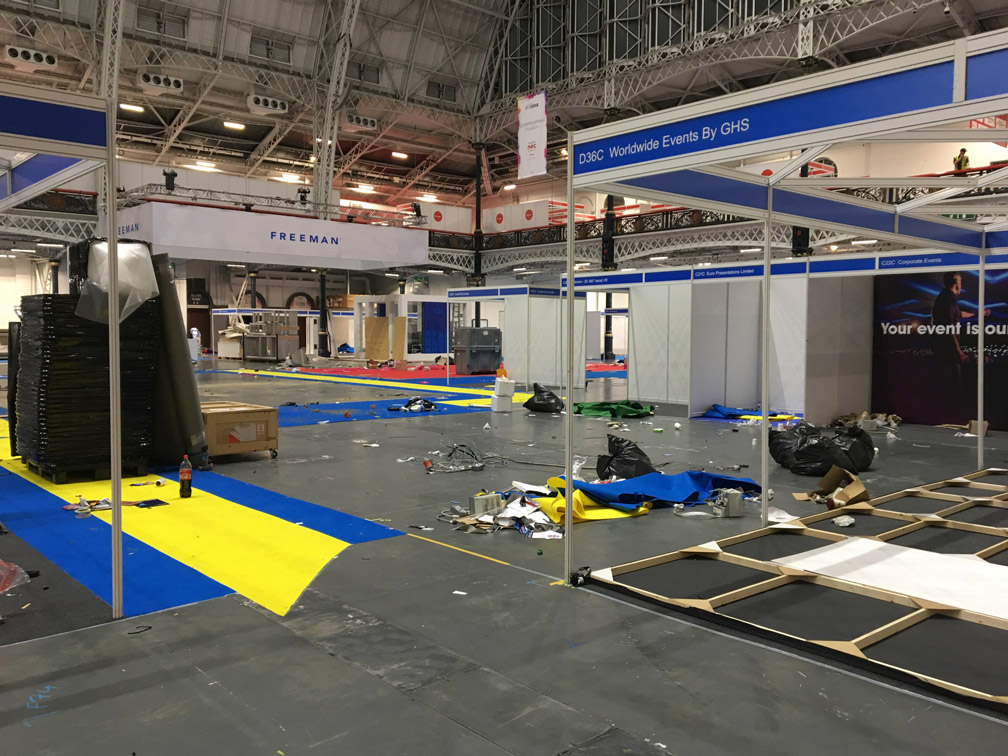
What about the food?
Trying to know how many people are surely attending the event enables to better anticipate food quantities and avoid food waste. The leftovers and food waste can also be given to associations. In addition, an event can also improve its carbon footprint by keeping things as local as possible when it comes to food or features for the event.
Concerning the plastic waste due to stands?
When it comes to plastic use, events’ stands waste a lot. First of all, they are, in most cases, used for a one-time purpose. This means that afterwards they are thrown away and not reused. Moreover, stand builders often paint them directly on-site, generating a lot of chemical waste too. Conventional paints are not sustainable and can lead to health problems since they contain some toxic ingredients, but natural paints are a better solution. Natural paints have recycled, natural or bio-based content. Then to wrap and protect all the stand elements (structure, panels, etc.) companies often use a huge amount of plastic which they throw away, instead of keeping it for later and reuse it.
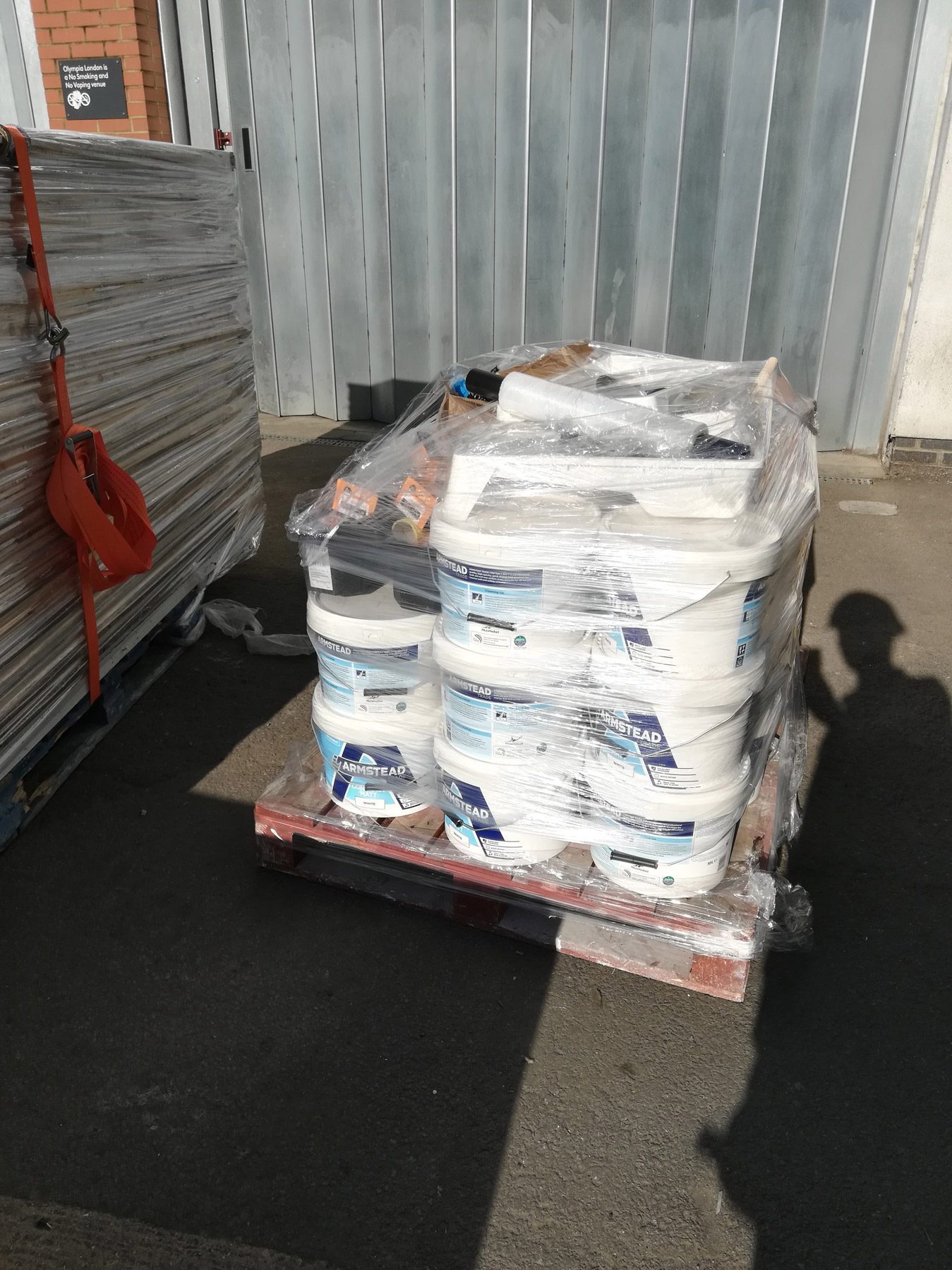
And regarding the lights?
For the lightning, LED lights are way better and save energy but it is also possible to lower power efficiency to avoid energy waste. A white screen is a very good investment to project all the content digitally and to avoid all the panels and printed posters that are commonly used to show data and information.
Other tips?
An easy way for a venue to go greener is to make sure to recycle all the waste generated during the event, or to hire volunteers who could collect waste. In addition, all the waste such as the structures, stands and leftovers products should be donated to interested organizations and charities. Finally, a partnership with public transport should be developed and car-sharing should be encouraged. Some venues even have an International Sustainability Certification, such
as Manchester Central or ACC Liverpool, and choosing one of those options enables to boost the credibility of a sustainable event.
To conclude, there are many ways to reduce the carbon footprint when organizing events, and it only takes a very simple action to act for the best of our planet!
Sources:
https://helloendless.com/sustainable-event-trend/
https://www.eventbrite.co.uk/blog/plan-a-green-event-ds00/
https://aushimkoumar.com/2018/12/21/the-new-trend-in-exhibition-stands/
https://www.sciencedirect.com/science/article/pii/S0956053X09000075
https://www.tsnn.com/blog/why-going-green-matters-your-next-tradeshow
https://globalwarmingisreal.com/2012/11/26/5-industries-that-need-way-more-eco-attention/
https://smashhitdisplays.com/blog/trade-show-news/trade-show-industry-creating-most-of-the-worlds-waste
http://www.enviropaedia.com/topic/default.php?topic_id=183
https://www.tickpick.com/a-guide-to-planning-green-events
Konligo launches a brand new intuitive Website
Konligo is a Belgian start-up, pioneer in developing local, innovative and sustainable stand
structures for indoor exhibitions and outdoor events. Having been in the to-do list for the past
weeks, the arrival of this fresh new website promises to offer a fully intuitive and smooth user
experience.
The attractive design and improved functionality will now enable navigation with a multitude of
devices: laptops, mobile devices, tablets.. The enriched content, dynamic atmosphere and easy
surfing offers a really enjoyable and efficient moment/journey for customers, partners, media,
visitors.
Last but not least the website tends to reflect the virtues/advantages/assets Konligo delivers in real
life , namely usefulness, eye-catchy and straight to the point.
“We are very enthusiastic about the launch. For this web site, designed by Capital Panache, we
pay particular attention to the responsive experience we wanted our visitors to get, since it is
deeply in sync with the genuine and inspiring experience our customers have with our products
IRL”. Said Aushim Koumar, Founder at Konligo.
Our website will be updated on a regular basis with news, events, new products.
For more information, visit www.konligo.com / Follow @Konligo on Twitter
The new exhibition trend
The new exhibition trend.
Every year, ten-thousands of conferences and tradeshows take place around the world. Together, these 31,000 exhibitions attract more than 4.4 million companies who showcase their products and services to 260 million visitors.
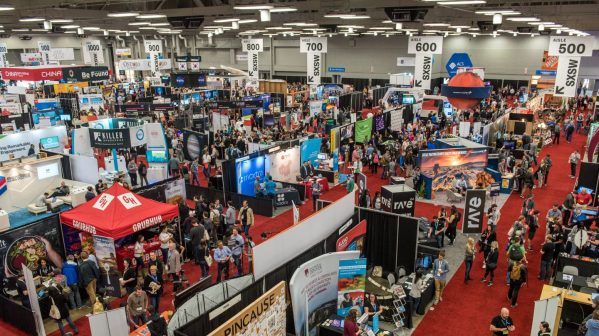
An overwhelming majority of these fairs (80%) are business-to-business events that last between two to three days. A typical business-to-business fair takes three to four days of preparation and one to two days to disassemble. In other words, the process of building up and taking down a business-to-business trade show is double that of the fair’s actual duration.
The budget spent on the infrastructure for these trade shows – mostly stands – is estimated at €60 billion, or an average of €2 million per fair.
Compared to trade shows, the world of business-to-consumer festivals and events is a thrifty one. Roughly 200,000 outdoor events are organised globally every year for a total budget of €20 billion. That means that €30,000 is spent on outdoor infrastructure per event.
What explains this dizzying, million-euro difference in budget? Organisers of outdoor festivals and events want to create memories and visibility for a company, and they are mostly business-to-consumer. For the tradeshow industry, the end game is to close business deals and that’s worth spending some money.
The illusion of permanence.
Every trade show exhibitor wants to stand out and impress prospective and current clients with a unique, eye-catching structure. At the same time, almost every exhibitor wants to create an atmosphere that feels anything but ephemeral. They want a stand that offers the illusion of permanence and gives visitors the impression that they’re standing in a real store.
But this emphasis on permanence doesn’t come cheap. Hundreds of people are needed to construct the trade show stands. To create a seemingly permanent display, the workers must plaster and paint over dozens of wooden panels and use coverings to hide the stands’ framework. This is the number-one reason that exhibition stands have such a lengthy installation time and steep cost.
This high price tag also means that stand builders are under pressure to keep labour costs as low as possible. Many of them for instance hire busloads of foreign workers, often from eastern European counties, and bring them to Belgium to construct and disassemble the stands. As soon as the job is done, these workers are shuttled back to their home countries.
Sustainable is the new black.
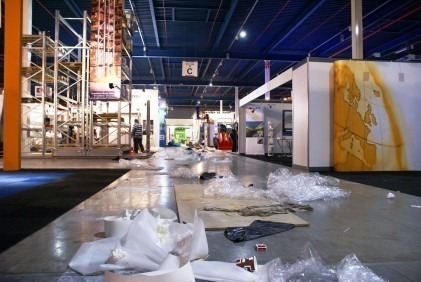
The mountain of waste that these 31,000 fairs generate, however, is perhaps what’s most disturbing. Because it’s easier to throw all the used materials away than to stock and re-use them. Tonnes of wooden panels, walls, furniture and decorative elements are discarded with every fair. Re-use is moreover not sexy because used materials don’t produce the new and permanent feeling exhibitors are looking for.
With their robust, modular aluminium stands, companies like Octanorm, BeMatrix and Aluvision are thankfully starting to put a dent in the amount of waste produced by tradeshows.
But when it comes to the large eye-catching structures seen at most tradeshows, there is still a long way to go. The emphasis on permanent-looking structures at temporary events remains the norm.
But why? Why hide a stand’s structural elements and cover it with panels, plaster and paint? Why give visitors the impression that the structure around them is a permanent one when a mere step outside the exhibition booth immediately shatters that illusion and brings them back to the here and now of the fair? Isn’t this a bit absurd?
We are moving in precisely the opposite direction in other areas of life. In digital marketing for instance consumers are thirsting for more authentic messages. Tired of scripted, slick advertisements, they want more spontaneous videos, without make-up and filters.
Something similar is happening in interior design. More and more, we are going back to incandescent light bulbs, to coloured electrical wires and to rougher designs in our homes. Things that once used to be hidden are now seen as integral elements of our decoration that deserve to be seen.
The world of exhibition stands is moving in a similar direction. Forward-thinking exhibitors today want rougher-looking temporary designs that are fully re-usable because sustainable authenticity is the new black. More and more, they are embracing authentic-looking stands and more genuine business-to-business exchanges.
Companies want to communicate what they stand for openly and transparently, and half-open stands with rougher designs go hand in glove with this trend. Instead of trying to disguise a structure’s temporary aspect, exhibitors are making it a central part of the design and refusing to hide its structural elements. What you see is what you get.
Under pressure
“1 on ten start-ups will be a success, 2 or 3 will survive more than 3 years and the remaining start-ups will fail”. Welcome in the start-up world.
So it began, more or less one year ago, my start-up journey. I was amazed by those stats I heard from the very beginning, but that excited me even more. Indeed, because all around us triumph is made more visible than failure, we overestimate our chance of success. And rightly so, the entrepreneur journey is already hard enough and – without optimism – almost impossible to bear.
The months that followed, I was caught in this start-up hype of people using Facebook, Uber, Tesla and Apple as examples of how we should manage our start-up. I was taught that we should set the bar high and have great expectations, but is this generated pressure really so healthy? Shouldn’t we adapt our speech for the 99% of the start-ups that will not become that great? Or for the 90% that will not be considered as a success? These 90% of start-ups that will not deliver the 10x return after 5 years, something that all venture capitalists are looking for.
To be honest, I’ve struggled with this, having a hardware start-up where scalability is a big issue. I knew that it would be very difficult for Konligo to realise that 10x return, but the pressure was high. Almost every person I met was urging me to define a business model where I could prove that I could realise this 10x return, that Konligo was the next “biggest tent producer worldwide”.
So I spent some months breaking my head and convincing myself that Konligo could do it, and that caused me more harm than good. Even though I have the greatest team members I could wish for, I began to feel demotivated and wasn’t looking at the real facts anymore, because I was “haunted” by this factor 10. “If we don’t meet that expectation Konligo will be a failure” I thought.
Until I let the pressure go. Until I realised that this wasn’t the reason why we started Konligo, why I was part of this adventure. I wasn’t part of this adventure because I wanted to sell the company in 5 years, cashing tons of money. Money has never been my motivation. I wasn’t part of this adventure to be in the Fortune 500, not at all. I was part of this adventure because I believed people would be impressed, fascinated and even finding it kind of magical to see our structures being deployed. You know the facial expression a child has when he discovers something fascinating? Well I wanted to see the same expression on adults’ faces when they see our structure. And this is still my motivation. So why would I care about the 10x return in 5 years?
At that moment I felt relieved, and I was able to think rationally again. We looked at the facts, and we found a business model that was in concordance with our team’s motivation and expertise. Our dedicated team and unique 15-years research expertise on the field gives us such a head-start compared to all our competitors that we don’t have to focus on this magical “barrier” of “5 years”. As a matter of fact, we only hear about the companies in the Fortune 500 when they are famous, and we tend to forget that most of them had a hard start.
Will Konligo not be considered a start-up success if we don’t reach the 10x return after 5 years? Well so be it. What is the definition of a start-up anyway? I prefer to define Konligo as a SME (Small-Medium Enterprise) with an amazing and motivated team that is discovering and loving the exciting adventure of entrepreneurship. And what I know for sure is that we will do everything we can to extend this adventure for quite some years! And that, dear reader, is my start-up world.
Privilege is invisible to those who have it
Making privilege
visible.
I recently witnessed a scene between a beggar and a well-suited man.
The beggar was asking the business guy money while he was withdrawing his cash. The latter started screaming at the beggar: “I’ve worked hard all my life to have the money I own now. And you, lazy bastard, what do you do besides asking people for money?!”. And he walked away towards his beautiful sport car, waving with his money to the beggar.
This scene shocked me: a true example of a lack of empathy and a lack of realising the privileges some of us have.
Understanding our privileges
Understanding our privileges is difficult because we are used to have them. This is typical behaviour of the human being: taking what one has for granted and only realising what one has once it’s gone. Privileges however are not easy to lose. We have them, or we don’t.
Privileges are therefore invisible to those who have them. But take some time to think about your privileges. Could you sum up some of them? Let me help you.
- Does one or both of your parents have a college degree?
- Have you always assumed you’ll go to college?
- Are you able to move through the world without fear of sexual assault?
- Did you ever have to skip a meal or were hungry because there was not enough money to buy food?
- Were you ever discouraged from an activity because of your race, class, ethnicity, gender, disability, or sexual orientation?
- Do you have more than fifty books in your household?
- Did your parents tell you that you can be anything you want to be?
And this is just a very small list of the privileges some of us have, and others don’t.
The link below shows a video derived from the exercise The Privilege Walk in which I recently participated. That exercise opened my eyes and made me realise that within the same university, there is a huge difference in privileges between students: https://www.youtube.com/watch?v=4K5fbQ1-zps
Stop judging, because not everyone has the same privileges as you
Privileges make a difference in determining someone’s future, in what a person will become, and how hard he will have to fight to reach his goal. However, as we tend to forget our privileges, we judge others by thinking that they had the same opportunities we had to be the person we are now. Nothing, however, is further from the truth. We are all different and that means that we cannot judge someone else if we don’t know what that person has been through or which privileges that person didn’t have.
So, let’s not judge the beggar, the cleaning lady, the waste collector, or whomever you may meet in your business or private live. What do you gain by judging them? What do you gain by feeling superior? I would say that we need to understand their stories before having an opinion about them. And if we don’t know them, then why bothering having an opinion about them? Let’s focus instead on things that really matter, like how to better yourself personally and professionally.
At Konligo , we try to breathe these core values every day, making working here a real pleasure.
Stop keeping score
The Go-Giver: A Little Story About A Powerful Business Idea – Bob Burg & John David Mann.
This very powerful quote is for me the foundation of every good relationship, personal and professional. I call it the “Art of Giving”: giving to others not because you must, not because you want something in return, but just because it’s your way of life.
As I told in a previous article, I was scared that I would have to put my values aside in the corporate world, but nothing could be less true. The book “The Go-Giver” was an eye-opener for me. Not only the content, but also the supporting community behind it showed me how many corporate people there are willing to give, just because it’s in their nature.
I decided to dedicate my tenth article to this very powerful book, and to highlight three of its most powerful messages.
Money shouldn’t be your focus, even if it’s your target
“You see? You can’t go in two directions at once. Trying to be successful with making money as our goal is like trying to travel a superhighway at seventy miles an hour with your eyes glued to the rear-view mirror.”
Even if every entrepreneur’s dream is to be successful – and for the majority this means making a lot of money with their business-, the book explains that this target cannot be reached when focussing only on the money part. You should keep a global view on your business and strive to reach success by focussing more on giving to others. It’s by working on your relationships, by building a community around you and by being true to yourself that you can reach your targets.
Be true to yourself, be authentic
“The most valuable thing you have to give people is yourself”
This is so true, and yet so scarce in our society. We lack authentic persons, persons that have values and norms and stick to them, regardless of the difficulty of the situation . Be authentic, and people will respect you for who you are.
To be authentic, however, you should first define your own values and norms. And in my opinion, being transparent and avoiding gossiping is one of the most important core values. A person’s authenticity and trustworthiness is for me deeply damaged when hearing him talking behind someone’s back.
Be open to receiving
“Every giving can happen only because it is also a receiving”
This is the most powerful advice I got from the book. The art of RECEIVING.
I always love to give, but when receiving, I feel embarrassed. For example, I do like to give compliments but if someone pays me a compliment, I deny it by replying“oh it’s nothing” or immediately trying to minimise what I did. This also count for my private life: I prefer to do something for someone, in the opposite case I feel guilty.
But this is a wrong mindset. And it hit me, thankfully, when reading the passage in the book when the main character (Joe) and his mentor Pindar were having a discussion. Not quoting this part would be denying you – in my opinion – the most important thought of the whole book.
It’s not better to give than to receive. It’s insane to try to give and not receive. Trying not to receive is not only foolish, it’s arrogant. When someone gives you a gift, what gives you the right to refuse it – to deny their right to give?
Receiving is the natural result of giving. If you give and then try to stop the receiving that comes back, you’re like King Canute watching the tide roll out and commanding it not to come back in. It has to come back in, just as your heart has to contract after relaxing.
I can’t deny it, I’m still struggling with this “law”. Really, It was a slap in my face, especially the sentence: “Trying not to receive is not only foolish, it’s arrogant”. I never looked at it that way and I’m incredible thankful to “Pindar” for teaching me this lesson which I try to apply every day.
The main take away message of this article is that “The Go-Giver: A Little Story About A Powerful Business Idea” is a must read book (and fortunately also a short one). It teaches you to appreciate the value of giving and staying true to yourself. And for those who are already familiar with the latter mentality, the book makes you realise that receiving is as important as giving: one can’t fully be perceived without the other.
